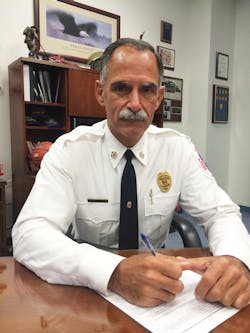Chief Concerns: Our Dirty Little Secrets
In last month’s column, we addressed nutrition, specifically our unhealthy relationship with food and drinks, and I offered some advice related to sugar intake, food time management and physical fitness. This month we’ll look at some of our other secrets, namely those related to alcohol, drugs, mental health issues and reckless driving.
Alcohol and drugs
The 64,000-pound elephant in the room with this whole discussion is alcohol, drugs and their connection to mental health. In the interest of full disclosure, I am a teetotaler—no alcohol (or drugs) by CHOICE. No religious or ideological objection, just a personal upbringing and choice. Many in our midst make a conscious (or unconscious) choice to drink alcohol, often much more than the “occasional drinker.”
The irony of many of these conferences I referenced earlier is the health, wellness and mental health classes, followed by happy hour and the open bar with the vendors. Now I know this statement will be highly unpopular amongst many of my peers and subordinates, but how hypocritical is it of US to follow those healthy choices classes with a “management-endorsed” drink-fest? Not judging, just making a statement.
Alcohol itself isn’t the problem. WE are the problem, and WE have a responsibility to ensure that we drink and act responsibly. The oxymoron of that statement is that the alcohol’s effect on the brain and nervous system are what typically make us act irresponsibly. Designated drivers are critical; however, personal responsibility is more important.
The last comment I’ll pass along about alcohol refers to professional demeanor, which is usually lacking during these drink fests. You should never drink alcohol while in uniform or wearing anything that identifies you as a firefighter, nor should you allow your folks to do so. Not only is this a horrible presentation to the public, but it’s also part of that moral focus that reverberates through the relationships you and your department have with your constituents and communities.
When it comes to drug use, there’s no place in our business for the use of illegal drugs or the misuse of prescription drugs. Your department better have a written zero-tolerance policy about illegal drugs and prescription drug abuse. Too many times, drugs, alcohol and other vices become the coping mechanisms of choice, often leading to unsuccessful life outcomes. We must ensure that we have policies and programs in place and/or at our disposal to help our folks and/or remove them from positions of public contact if necessary. Individual well-being, the public’s trust and your organization’s reliability and reputation are at stake.
Mental health
Suicide in our public safety sector (firefighters, EMTs, paramedics, police officers, call-takers and dispatchers) is becoming a huge issue. This is probably the biggest “secret” in our business. Only recently have fire service leaders paid real attention to suicide prevention within our business. Many organizations—including the IAFC, the National Fallen Firefighters Foundation, the Department of Justice and many others—are beginning to pay attention.
Please take time to visit the resources provided below to better recognize the signs and symptoms of mental health issues in members within your own organization. From my department’s own personal experience, I assure you that critical incident stress management (CISM) is useful and post-traumatic stress disorder (PTSD) is real. Please don’t underestimate the value of CISM programs, nor the signs of PTSD. Cumulatively, the absence of CISM capacity and the presence of unmanaged PTSD will spell disaster within your organization.
Driving dangers
The last piece we’ll talk about is our crazy driving. How many times have you blown that red light? Yeah, yeah, yeah, I’ve heard it a million times: “Chief, our policy allows us to run red lights; we have the right of way!” Well, it’s time for you to change your policy! Neither your policy nor any law out there gives you the right to plow over and kill Mrs. Jones and her family. How about seatbelts, turn signals and emergency response protocols? We could fill a whole book with information about it, review laws and watch hours of videos that should be convincing us of the importance of seatbelts and turn signals and the dangers with distracted driving.
In sum
Taking care of each other is our responsibility. Taking care of yourself is harder. Take time to relax, focus on your mental health, and consider whether you engage in any reckless behavior that needs to be addressed. Plus, as we discussed last month, if you don't eat a little bit less, eat a little bit better and exercise more, some of us are not going to be here next year. It’s time to WAKE UP so our “dirty little secrets” aren’t killing us, one firefighter, EMT and paramedic at a time!
References
Tackling Fire Service Suicide: A Reality Check. On Scene (International Association of Fire Chiefs). Jan. 15, 2015, www.iafc.org/onScene/article.cfm?ItemNumber=8223
National Fallen Firefighters Foundation Statement about Suicide Prevention, Aug. 15, 2014, www.firehero.org/2014/08/15/national-fallen-firefighters-foundation-issues-statement-suicide-prevention
The Fire That Burns Within: Fire Service Suicide Prevention, Department of Justice program, http://firefightersuicide.spcollege.edu/toolkit.html
About the Author

Marc S. Bashoor
MARC S. BASHOOR joined the fire service in 1981. In 2017, he retired as fire chief of Prince George’s County, MD, Fire/EMS, the largest combination department in North America. His progressive community-based approach led to record hiring and a strategic apparatus replacement plan.
Twitter: @ChiefBashoor
Email: [email protected]
